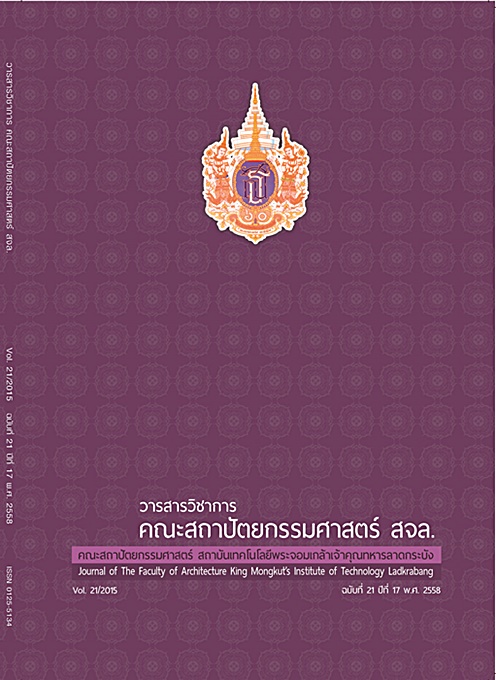ระบบทางส่งน้ำโรมัน ( Roman Aquaduct System)
Main Article Content
Abstract
บทคัดย่อ
ในยุคโรมันโบราณ กรุงโรมมีประชากรมากถึงหนึ่งล้านคน ในคริสต์ศตวรรษที่ 1 การที่มีคนมาอยู่รวมตัวกันมาก
ขนาดนั้น ความต้องการพื้นฐานจะมีความจำเป็นอย่างยิ่งในการดำรงชีวิต ไม่ว่าจะเป็นปัจจัย 4 เช่น เรื่องของ อาหาร น้ำ
เครื่องนุ่งห่ม ที่อยู่อาศัย ยารักษาโรค ในบทความนี้จะศึกษาในเรื่องของน้ำที่มาใช้หล่อเลี้ยงกรุงโรมเป็นหลัก ข้อมูลที่นำมาอ้างอิงประกอบศึกษาได้จากหลายแหล่ง เช่น หนังสือ บทความทางวิชาการ รวมถึงข้อมูลสารสนเทศ วีดิทัศน์ต่างๆ จาก YouTube Google Earth ที่เป็นสื่ออิเล็กทรอนิกส์ที่สามารถทำให้เห็นภาพที่เคลื่อนไหวและได้ยินเสียงเว็บไซต์ที่เขียนเกี่ยวกับระบบทางส่งน้ำ(อควาดัค - Aqueduct) ต่างๆ โดยเฉพาะหนังสือทางสถาปัตยกรรมชุดแรกที่เขียนโดย Marcus Vitruvius Pollio - The ten Books on Architecture ได้มีการเขียนบันทึกในบทที่กล่าวถึงการหาน้ำเพื่อมาหล่อเลี้ยงเมืองขนาดใหญ่โดยเฉพาะระบบสุขาภิบาล (Sanitary System) จะเห็นได้ว่าความเข้าใจในเรื่องของวิศวกรรมน้ำ (Hydrology engineering) เป็นสิ่งที่ชาวโรมันสามารถทำได้เป็นอย่างดี วิศวกรโรมันใช้หลักการพื้นฐานของน้ำที่ไหลจากที่สูงลงสู่ที่ต่ำรวมถึงกฎของแรงดันน้ำมาบังคับทิศทางของน้ำไปสู่ตัวเมือง จากต้นน้ำที่อยู่ไกลหลายสิบกิโลเมตร (บางเส้นทางมีความยาวกว่าร้อยกิโลเมตร) บนภูเขาที่เป็นต้นน้ำ รวมถึงสามารถป้องกันไม่ให้น้ำถูกปนเปื้อนจากสภาพแวดล้อม และไหลลงมาถึงกรุงโรม มีการส่งน้ำที่มีคุณภาพดีกระจายให้ใช้งานเป็นสาธารณะ มีงานนำน้ำพุที่มีชื่อเสียงบางแห่งยังใช้งานได้ดีจนถึงปัจจุบัน เช่น น้ำพุทรีวี (Trevi Fountain) ในโรมระบบระบายน้ำนี้ยังรวมถึงการบำบัดของเสียของเมือง (Sewage System) ที่ทำความสะอาดให้กับกรุงโรมอีกด้วย
พื้นฐานของการไหลของน้ำจากที่สูงลงสู่ที่ต่ำนั้นเป็นหลักการง่ายๆ ที่ทุกคนสามารถเข้าใจได้ แต่ชาวโรมันต้องมี
ความเชี่ยวชาญในการที่จะบังคับการไหลของน้ำและการจัดการเรื่องระดับ เพื่อให้น้ำค่อยๆ ไหลจากภูเขาสูง ต้นน้ำ ลงมาสู่เมืองการทำทางส่งน้ำมีอยู่สามวิธีคือ 1. เจาะทะลุภูเขา 2. สร้างสะพานส่งน้ำ 3. ใช้หลักการกาลักน้ำ ทั้งนี้การที่จะทำให้น้ำไหลได้อย่างต่อเนื่อง จะต้องมีวิธีการกำหนดเส้นทางและการลาดเอียง ดังนั้นงานสำรวจและก่อสร้างต้องมีความแม่นยำ คำถามคือ ชาวโรมันทำได้อย่างไร วิศวกรโรมันต้องใช้เทคนิคและวิธีการก่อสร้างเฉพาะ มีเครื่องมือเครื่องใช้ที่สามารถวัดระยะต่างๆทั้งแนวดิ่งและแนวราบเพื่อใช้ในงานก่อสร้าง สิ่งที่ทำให้งานก่อสร้างของกรุงโรมพัฒนาอย่างก้าวกระโดดคือการคิดค้นวัสดุ เช่น ซีเมนต์ (Cement) เพื่องานก่อสร้างโครงสร้างขนาดใหญ่ นอกจากนั้น วัสดุที่โรมันสามารถนำมาใช้ทำท่อส่งน้ำต่างๆ เช่น ท่อดีบุก (Lead Pipe) หรือ ท่อดินเผา (Clay Pipe) ที่นำมาใช้ในลักษณะเฉพาะของท่อส่งน้ำสำหรับเพิ่มแรงดัน นับเป็นวิวัฒนาการในการใช้วัสดุสำหรับการก่อสร้างที่พัฒนาได้ดี วิศวกรชาวโรมันได้ค้นคิดวิธีการถ่ายแรงของโครงสร้างผนัง หรือกำแพงโดยระบบการถ่ายแรงแบบโค้ง (Roman Arch) เพื่อกระจายน้ำหนักของโครงสร้างทำให้เกิดช่องเปิดบนกำแพงและสามารถลดปริมาณวัสดุที่ใช่ก่อสร้างได้อย่างมาก จะเห็นได้ว่ากรุงโรมเป็นต้นแบบของอารยธรรมของเมืองขนาดใหญ่ต่อจากกรีก การที่ชาวโรมันมีน้ำสะอาด และมีน้ำช้ที่เป็นสาธารณะนั้นจะต้องมีกระบวนการจัดการอย่างยิ่งใหญ่ มีการบันทึกว่า โรมใช้แรงงานกว่า 700 คนในการดูแลทางส่งน้ำต่างๆ ให้อยู่ในสภาพสมบูรณ์ การมีน้ำใช้ในกรุงโรมเป็นมิติทางวัฒนธรรมและการใช้ชีวิตกรุงโรมมีที่อาบนน้ำสาธารณะขนาดใหญ่ ที่ประกอบด้วยบ่อน้ำร้อนและน้ำเย็น เป็นที่พบปะของเหล่านักคิด ผู้ปกครองต่างๆ มีการทำเหรียญที่ระลึกในช่วงของเวลาของการก่อสร้างทางส่งน้ำอควาดัค (Aqueduct) เป็นสิ่งบ่งบอกถึงวันเวลาในการก่อสร้างและเป็นรากฐานของระบบการเงินการคลัง การปรากฏน้ำพุในเมืองไม่เป็นเพียงให้มีน้ำสะอาดไว้ใช้ แต่ยังเป็นเสมือนเครื่องปรับอากาศที่พ่นฝอยน้ำเพื่อลดอุณหภูมิของเมืองได้เป็นอย่างดี มีการบริหารจัดการน้ำที่แจกจ่ายให้ประชาชนกว่าหนึ่งล้านคนรวมถึงในมิติของงานออกแบบเป็นสิ่งที่นักศึกษาสถาปัตยกรรมควรศึกษาเส้นทางส่งน้ำอควาดัคเป็นองค์ประกอบของการออกแบบผังเมืองที่มีมิติทางวัฒนธรรม และอควาดัคยังแสดงให้เห็นถึงหลักการพื้นฐานของงานก่อสร้างทางวิศวกรรม สถาปัตยกรรมได้เป็นอย่างดี
สิ่งที่ชาวโรมันได้สร้างไว้ ณ กรุงโรม ทำให้เห็นถึงวิวัฒนาการทางงานวิศวกรรมและสถาปัตยกรรมที่ยิ่งใหญ่ ความสามารถในการบังคับธรรมชาติเพื่อสนองความต้องการของการอุปโภคบริโภคของมนุษย์ การเข้าใจในธรรมชาติของน้ำที่ไหลจากที่สูงลงสู่ที่ต่ำและมีแรงดันน้ำที่นำมาใช้เป็นพลังงานได้นับว่าเป็นวิวัฒนาการที่ยิ่งใหญ่ก่อนยุคปฎิวัติอุตสาหกรรม การที่มีน้ำพุขนาดใหญ่กลางเมืองโดยที่ไม่ใช้กระแสไฟฟ้าหรือปั๊มน้ำนั้นเป็นสิ่งที่คนในปัจจุบันยังไม่สามารถจินตนาการได้ นักท่องเที่ยวได้แต่พร่ำบ่นว่า กรุงโรมทำไมใช้น้ำเปลืองและเปิดน้ำทิ้งที่น้ำพุต่างๆ ตลอดเวลา ย้อนกลับมาดูสิ่งที่เกิดขึ้นกับกรุงเทพฯ หรือเมืองใหญ่ๆ ที่เป็นมหานคร (Mega City) เช่นในปัจจุบัน (พ.ศ. 2558) การบริหารจัดการน้ำที่มีทั้งน้ำท่วมใหญ่ และน้ำแล้งทั้งๆ ที่มีวิวัฒนาการ มีเทคโนโลยีชั้นสูง กลับหลงลืมพื้นฐานในการจัดการน้ำ ที่เป็นปัจจัยพื้นฐานในการดำรงชีวิต
คำสำคัญ : ทางส่งน้ำอควาดัค การจัดการน้ำ สะพานส่งน้ำ กาลักน้ำ โครงสร้างโค้งโรมัน
Abstract
Ancient Civilisation, Rome populations grew more than a million people in AD. 1. When you have population of this size, the basic needs to sustain all inhabitants consisting of 1) food & water 2) clothing 3) shelter and 4) medicine. In this article will focus on water that supply an ancient city like Rome. The sources of information come from books, research papers, also many websites that bring Roman to your desktop, such as You Tube, Google Earth, using these technology that you can experience aqueduct with-out traveling to Rome. The first textbook about architecture, written by Marcus Vitruvius Pollio - The ten books on architecture has a chapter on this subject. The Roman has a great knowledge on Hydrology Engineering, especially sanitary system. The flow of water runs form high ground to the city without electric power like
today. Roman use the water pressure to work on mining and agriculture as well. Today, The Trevi Fountain in Rome is still flowing. Water is also used for cleaning the city of Rome.
Basic knowledge of gravitational, water flow from high ground to low ground, is simple knowledge to everyone. The Roman knows more of controlling direction of water from mountain to city. There are three ways to direct water 1) tunnel through the mountain 2) two-tier bridge and 3) siphon. The flow has to be constant so that the supply of water can be continuous. The slope and direction needs to be survey with precision. The question is how the Roman construct aqueduct. Roman engineer has tools and knowledge on engineering and the materials that make Roman advance in construction is Cement. They use it to construct a large scale structure, as a bonding structural element. The use of lead pipe and clay pipe also helps in direct-water to the needed location, and control pressure where it needed. Another leap of Roman engineering
is a Roman arch. Its transfer structure load on bearing wall in an arch form, reduce the construction material and structure load. It creates the opening on solid wall. Rome is a good example of a mega city after Greek, it has public water for everyone to use. Aqueduct is a large scale management. There was a record of 700 workers to care for aqueducts, keep it constant flow of fresh water. Rome use water as a cultural and a way of living. Bath house in Rome was a meeting place for scholars and thinker. During the construction of aqueduct the coin to celebrate the opening has been made. Its date the construction era and exhibit the economics society. Fountain in the city is not only supply fresh water, but also a spray of water droplets to cool down surrounding. This will reduce temperature in the city just like air-condition. Water management of Rome is a public amenity that supply over a million inhabitant. The design of aqueduct is a great architectural design and an element of urban fabric.
Roman aqueduct was a great achievement in architecture and engineering. It shows that man has try to control nature, to satisfy the human needs. The understanding of liquid flow and water pressure is a great knowledge, before the industrial revolution. Fountain and aqueduct that bring abundant of water to Rome
without the use of electricity is unimaginable for today traveller. From 2,000 years ago, comparing with the city such as Bangkok (2015), a mega city that still have problems with flooding and drought. The city planner need to be aware of this basic knowledge in water management, and turns it to be a way of city life.
Keywords : Aqueduct Water Management Two-Tier Bridge Siphon Roman Arch
Article Details
This work is licensed under a Creative Commons Attribution-NonCommercial-ShareAlike 4.0 International License.
Copyright Transfer Statement
The copyright of this article is transferred to Journal of The Faculty of Architecture King Mongkut's Institute of Technology Ladkrabang with effect if and when the article is accepted for publication. The copyright transfer covers the exclusive right to reproduce and distribute the article, including reprints, translations, photographic reproductions, electronic form (offline, online) or any other reproductions of similar nature.
The author warrants that this contribution is original and that he/she has full power to make this grant. The author signs for and accepts responsibility for releasing this material on behalf of any and all co-authors.


